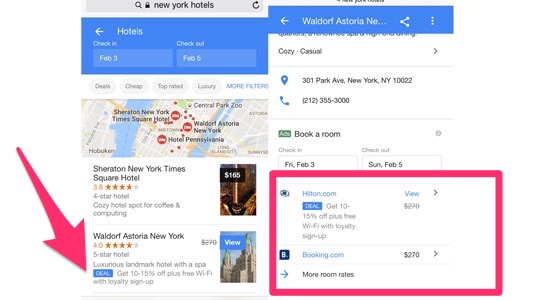
Google adds airfare forecasts and hotel loyalty marketing to metasearch
By cameron in Uncategorized
Even when Google enhances its search in unoriginal ways, the travel industry needs to take notice because the search giant might someday become a major booking tool for consumers.
Here are Google’s two most notable moves: It has begun to add airfare predictions to its metasearch tool. It has also begun to prominently encourage consumers to sign up for hotel loyalty programs for access to special rates or benefits — a ploy that dovetails with hotel chains’ efforts to encourage more direct booking.
Airfare forecasts
Adding predictions of price changes for plane tickets is a catch-up move. Fare forecasts have been common on a few travel metasearch platforms like FareCompare, Hopper, Kayak, and Momondo for some time.
But Google’s new predictions of fare changes — along with its new email alerts to warn users if fares are likely to increase — may lure some customers away from the established metasearch competitors, given its mammoth user install base and its superior load time for delivering comprehensive search results.
Google is starting to predict when fares are likely to rise for some specific flights and routes. It’s also forecasting how much a user might save by booking right away.
Users holding out for a better deal can now opt to track a flight or route and receive email alerts when fares are anticipated to change. The company says that “fare expiration and expected price jump notifications will be rolling out over the coming weeks everywhere Google Flights is available.”
Google is also adding tips, or pop-up boxes, with relevant shopping advice. For instance, a user may see a tip saying fares are expected to spike based on historic trends for a given route. The tip backs up its claim with specifics, saying how much the fare will probably rise and roughly when.
Hotel direct booking play
Google also has its eyes on hotels. Today the company says it has begun to inform travelers when savings or benefits like free wifi are available to loyalty members of hotel chains.
For example, users looking for New York City hotels this winter will see on the first screen of listings a message that they can “get 10-15% off plus free wifi with loyalty sign-up.”
That direct booking offer may look better than one from an online travel agency like Booking.com that may be quoting an otherwise competitive rate, as in this example:

This push of direct booking comes in the wake of Expedia’s recent experiment to promote loyalty program sign-ups with hotel chain Red Lion and its trial of promoting free services at more than 5,000 hotels.
Google is also making a couple of other small tweaks.
One change of note is that it is adding the ability for users to filter results to only see hotels that the company considers “deals.”
For now, the deal selection is “organic,” meaning it is based on an algorithm rather than marketing partnerships. A hotel is labeled a “deal” when its rate is lower than the historical average or “if there are discounts to the normal rate for those dates.”
A belated recognition of fare forecasting
It’s taken a long time for fare forecasting to have its global star turn.
It was back in 2003 when the concept of predicting airfares using data analytics first appeared with the startup Farecast. Around the same time Rick Seaney’s Fare Compare began to deliver a similar price-prediction service using a different methodology.
Farecast was a free service that helped travelers decide whether they should buy a ticket now or wait and hope that the fare drops. After raising $20.6 million, it was bought in 2008 by Microsoft for about $115 million. But Bing’s travel play never got traction with consumers.
Other travel metasearch brands dismissed fare forecasts and price tracking as gimmicks that didn’t lead to conversion.
But in 2013 Kayak added a price predictor tool, signaling a shift in industry views on the concept.
Last year, mobile-only startup Hopper claimed hockey-stick growth, and nabbed several mobile awards, for its service that relies heavily on fare forecasts and price tracking notifications.
Google’s move 13 years after the birth of the fare forecasting concept shows the long and winding route that some innovations take in the travel industry.
Increased pace of product development
The travel metasearch enhancements are coming much faster at Google than has historically been the case.
It’s only been three months since Google added airfare tracking, hotel deal spotting, and other filters to its metasearch. And the moves come in the same year as its expansion into inspiration tools and in-destination activity recommendation in its first standalone travel app.
Google’s pitch to hotels is that it is an effective way to boost direct bookings. Since summer 2015, Google Hotel Ads have worked on a commission model, which is more congenial to hotels than its original pay-per click model.
The trend spotlights the company’s renewed enthusiasm for its travel tools.
ANALYSIS: Book on Google – answers to hoteliers’ questions
EARLIER TODAY: Expedia lets hotels offer freebies as an alternative to rate cutting
Disclosure: Hopper CEO Fred Lalonde is also chairman of Tnooz.
![]()

